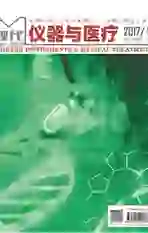胃肠道术后肠瘘的治疗及预后分析
2018-01-09栾响袁志香
栾响 袁志香
[摘 要] 目的:分析胃肠道术后肠瘘不同治疗方式的预后,总结治疗体会。方法:整理2013年10月至2017年2月74例胃肠道术后肠瘘患者临床资料,对其肠瘘位置、肠瘘类型、治疗方法及预后情况进行回顾性分析,总结胃肠道术后肠瘘治疗方式及治疗时机的选择策略。结果:患者肠瘘位置以低位瘘为主,占52.70%,其肠瘘形状、肠瘘数量、肠瘘流量分别以管状瘘、单发瘘、高流量瘘为主;患者肠瘘均于胃肠道术后2~14 d内发生,平均发生时间为(7.84±2.21)d,其中56例(75.68%)患者肠瘘发生于术后7~9 d。早期手术组住院时间最短,其次为晚期手术组,保守治疗组住院时间最长,差异有统计学意义(P<0.05),各组患者肠瘘复发率、治愈率比较,差异无统计学意义(P>0.05)。结论:确定性手术治疗胃肠道术后肠瘘的安全性良好,且可明显缩短住院时间,应全面评估患者手术指证,适时开展确定性手术。
[关键词] 胃肠道手术;肠瘘;预后
中图分类号:R656.6 文献标识码:A 文章编号:2095-5200(2017)05-004-03
DOI:10.11876/mimt201705002
The treatment and prognosis on the intestinal fistula following gastrointestinal tract operation LUAN Xiang, YUAN Zhixiang. (Department of General Surgery,Chengyang Peoples Hospital, Qingdao 266109, china)
[Abstract] Objective: The object of this study was to analyze the prognosis of different treatment on intestinal fistula following gastrointestinal tract operation and summarize the clinical experience. Methods: A total of 74 intestinal fistula clinical data between October 2013 and February were collected. The sites, types, treatment and prognosis of their intestinal fistula were retrospectively analyzed. Finally, the strategy on the treatment and its timing of intestinal fistula were summarized. Results: The low fistula accounted for the most in intestinal fistula site (52.70%). The shape, number and flow intestinal fistula were respectively dominated by the tube-shaped, single fistula and high flow; the intestinal fistula of all patients were occurred 2~14 days after gastrointestinal tract operation and the average time point was (7.84±2.21)days, of which 56 (75.68%) were occurred 7~9 days after gastrointestinal tract operation. The duration of hospitalization of early operation group was the shortest, followed by late operation group while the conservative treatment group was the longest, and the difference was statistically significant (P<0.05). The differences of recurrence rate and curative rate between these groups were not statistically significant (P>0.05). Conclusions: The definitive operative treatment is of higher security and shortens the length of hospitalization, which should be duly carried out.
[Key words] gastrointestinal tract operation; intestinal fistula; prognosis
肠瘘是指胃肠道与其他空腔脏器、体腔或体腔外的异常通道,肠内容物可经由此通道进入其他脏器或体外,引发感染、体液丢失、稳态失衡、器官功能不全等病理生理改变[1]。肠瘘为胃肠道术后常见的并发症[2],有中心认为,早期充分引流、控制腹腔感染、营养支持等保守治疗,可将腸瘘确定性手术的成功率提升至80%~90%[3],但也有中心倾向于肠瘘发生早期开展确定性手术[4]。此次研究回顾了74例患者资料,以明确胃肠道术后肠瘘的治疗方式及治疗时机。
1 资料与方法endprint
1.1 一般資料
整理我院2013年10月至2017年2月收治的74例胃肠道术后肠瘘患者临床资料,进行回顾性分析。患者均接受胃肠道手术,经术后腹腔CT、消化道造影等影像学检查及腹腔引流液、瘘口流出液等实验室检查明确肠瘘诊断且临床资料保存完整;排除合并食管瘘、胰瘘、胆瘘、肛周瘘者。74例患者中,男55例,女19例,年龄35~76岁,平均(46.19±8.34)岁。
1.2 治疗方案
74例患者均于确诊后接受肠瘘血红蛋白水平、生化参数常规监测,其中血红蛋白、血糖、尿素、电解质每隔2 d检测1次,肝肾功能每7 d检测1次,必要时重复行B超、CT、消化道造影等影像学检查[5]。保守治疗方案为:1)瘘口局部处理:清除溢出肠液,去除瘘口周围敷料,使用专用烤灯烘烤瘘口局部以保持清洁干燥,必要时使用吸引器;2)引流、感染控制:经腹部切口、原引流管或行非确定性手术置入引流管,持续滴注灌洗、负压引流,及时引出瘘口溢出肠液,瘘口皮肤使用氧化锌软膏保护;3)营养支持:肠外瘘确诊早期予以全胃肠外营养,根据瘘口引流量变化,待患者引流量明显降低、感染得到有效控制且可见窦道形成后,即由肠外营养逐渐过渡至完全肠内营养;4)控制肠液溢出量:使用微量泵泵入生长抑素,持续7~14 d,待肠液减少、感染控制、营养良好、瘘口可见肉芽组织生长且营养支持方式转变为肠内营养后,加用生长激素直至瘘口完全愈合;5)脏器功能维持:及时发现并处理休克、急性呼吸窘迫综合征、心功能不全等并发症,尽量避免多器官功能障碍综合征的发生;6)瘘口封堵:对于瘘以下肠襻通畅、瘘口可控、周围组织牢固(管状瘘)、愈合良好(唇状瘘)且感染控制者,可使用补片、粘合胶行外侧封堵,或使用内堵片、蛋白胶行内侧封堵[6-8]。
45例患者接受确定性手术治疗,其中18例手术范围偏小、感染局限且粘连较轻,于肠瘘发生后14 d内接受早期手术,其余27例手术范围较大、感染广泛且粘连较重,于肠瘘发生后15~90 d内接受晚期手术[8]。
治愈判定标准[10]:1)腹部瘘口及切口均愈合,未见肠液分泌;2)各项实验室指标检查结果恢复正常范围,全身情况较好;3)胃肠道功能恢复,可正常进食,无需肠内或肠外营养支持;4)腹部影像学检查未见明显瘘口。符合上述全部4条标准即可判定为治愈。
1.3 统计学分析
肠瘘复发率、治愈率以(n/%)表示,并采用χ2检验,住院时间以(x±s)表示,并采用t检验,SPSS18.0进行分析,以P<0.05为差异有统计学意义。
2 结果
患者肠瘘均于胃肠道术后2~14 d内发生,平均发生时间为(7.84±2.21)d,其中56例(75.68%)患者肠瘘发生于术后7~9 d。患者肠瘘位置以低位瘘为主,占52.70%,其肠瘘形状、肠瘘数量、肠瘘流量分别以管状瘘、单发瘘、高流量瘘为主,见表1。
早期手术组住院时间最短,其次为晚期手术组,保守治疗组住院时间最长,差异有统计学意义(P<0.05),各组患者肠瘘复发率、治愈率比较,差异无统计学意义(P>0.05),见表2。
3 讨论
胃肠道手术后发生肠瘘原因包括吻合口愈合不良、肠管误伤、切口裂开或腹壁缺损、腹腔感染、肠壁压迫穿孔等[11]。本研究75.68%的患者肠瘘发生于术后7~9 d,即考虑与吻合口周围炎性水肿逐渐向局限性腹膜炎、腹腔内脓肿的进展有关。肠瘘处置困难、预后差、病死率高,给临床医生和患者自身均带来了较大挑战。导致患者死亡率较高的主要原因为败血症、营养不良和水电解质紊乱的发生[12]。
20世纪70年代前,临床对于肠瘘的认识近似于肠破裂、肠穿孔,故治疗首选方案为手术修补,但多数患者瘘口周围感染严重、局部水肿明显且往往伴有较差的营养状态,超早期手术治疗难以避免瘘口再破溃,患者复发率高达60%~80%[13]。随着临床关于肠瘘病理生理改变的深入了解,研究证实,在早期充分引流、控制腹腔感染、营养支持等保守治疗3个月后,行确定性手术治疗,可将外科手术失败率降低至10%~20%[14]。然而,也有学者认为,该方案治疗耗时久、患者医疗费用负担较高,故于更早的时间点开展确定性手术,对于改善患者预后质量具有更为积极的作用[15]。
在本次研究74例患者中,60.81%的患者接受手术治疗,其治愈率达到80.00%,且肠瘘复发率控制在13.33%,显现出确定性手术可靠的安全性与良好的治疗效果,而且确定性手术能够明显缩短治疗周期,尤其是在肠瘘发生后14 d以内,待腹腔粘连可以分离时,行早期手术能够进一步缩短住院时间,且对肠瘘复发率、治愈率无明显不良影响。随着临床营养支持技术的不断改进、感染控制的成熟、引流器材的更新及抑制胃肠道分泌药物的应用,越来越多的患者腹腔粘连可得到早期控制,瘘口自行愈合时间明显缩短,有利于早期确定性手术开展[16]。当前肠瘘治疗的原则为“引流、等待、再手术”,即首先实施保守治疗,争取瘘口自行愈合,若患者2周内仍未见瘘口明显愈合,但腹腔粘连紧密性已明显下降,此时术中无需钝性分离,手术操作一般不会造成肠管浆膜层损伤,且可彻底清除腹腔内感染灶,更有利于吻合口的愈合[17]。因此,对于无严重腹腔感染、无其他严重并发症、无严重脏器功能障碍、无严重营养不良者,可考虑行早期确定性手术。若患者不符合早期确定性手术适应证,但存在其他影响愈合的不良因素,仍应在腹腔感染控制、炎症消退及营养状态改善后,尽早开展确定性手术[18]。
参 考 文 献
[1] Katayama H, Kurokawa Y, Nakamura K, et al. Extended Clavien-Dindo classification of surgical complications: Japan Clinical Oncology Group postoperative complications criteria[J]. Surg Today, 2016, 46(6): 668-685.endprint
[2] Nockolds C L, Hodde J P, Rooney P S. Abdominal wall reconstruction with components separation and mesh reinforcement in complex hernia repair[J]. BMC Surg, 2014, 14(1): 25.
[3] Connolly P T, Teubner A, Lees N P, et al. Outcome of reconstructive surgery for intestinal fistula in the open abdomen[J]. Ann Surg, 2008, 247(3):440-444.
[4] Allen P J, G?nen M, Brennan M F, et al. Pasireotide for postoperative pancreatic fistula[J]. N Engl J Med, 2014, 370(21): 2014-2022.
[5] Maggiori L, Khayat A, Treton X, et al. Laparoscopic approach for inflammatory bowel disease is a real alternative to open surgery: an experience with 574 consecutive patients[J]. Ann Surg, 2014, 260(2): 305-310.
[6] Graham J A. Conservative treatment of gastrointestinal fistulas[J]. Surg Gynecol Obstet, 1977, 144(4):512-4.
[7] Slater N J, Bokkerink W J V, Konijn V, et al. Safety and durability of one-stage repair of abdominal wall defects with enteric fistulas[J]. Ann Surg, 2015, 261(3): 553-557.
[8] Mennigen R, Senninger N, Laukoetter M G. Novel treatment options for perforations of the upper gastrointestinal tract: endoscopic vacuum therapy and over-the-scope clips[J]. World J Gastroenterol, 2014, 20(24): 7767.
[9] Mercky P, Gonzalez J M, Aimore Bonin E, et al. Usefulness of over the scope clipping system for closing digestive fistulas[J]. Dig Endosc, 2015, 27(1): 18-24.
[10] Pugh J I. On the pathology and behaviour of acquired non-traumatic vesico-intestinal fistula.[J]. Br J Surg, 2010, 51(9):644-657.
[11] Valle S J, Alzahrani N, Alzahrani S, et al. Enterocutaneous fistula in patients with peritoneal malignancy following cytoreductive surgery and hyperthermic intraperitoneal chemotherapy: Incidence, management and outcomes[J]. Surg Oncol, 2016, 25(3): 315-320.
[12] Panici P B, Di Donato V, Fischetti M, et al. Predictors of postoperative morbidity after cytoreduction for advanced ovarian cancer: Analysis and management of complications in upper abdominal surgery[J]. Gynecol Oncol, 2015, 137(3): 406-411.
[13] Gupta M, Sonar P, Kakodkar R, et al. Small bowel enterocutaneous fistulae: the merits of early surgery[J]. Indian J Surg, 2008, 70(6):303-307.
[14] Weniger M, DHaese J G, Angele M K, et al. Treatment options for chylous ascites after major abdominal surgery: a systematic review[J]. Am J Surg, 2016, 211(1): 206-213.
[15] Timmermans L, de Goede B, van Dijk S M, et al. Meta-analysis of sublay versus onlay mesh repair in incisional hernia surgery[J]. Am J Surg, 2014, 207(6): 980-988.
[16] Addeo P, Delpero J R, Paye F, et al. Pancreatic fistula after a pancreaticoduodenectomy for ductal adenocarcinoma and its association with morbidity: a multicentre study of the French Surgical Association[J]. HPB, 2014, 16(1): 46-55.
[17] Malleo G, Pulvirenti A, Marchegiani G, et al. Diagnosis and management of postoperative pancreatic fistula[J]. Langenbecks Arch Surg, 2014, 399(7): 801-810.
[18] Osland E, Yunus R M, Khan S, et al. Postoperative early major and minor complications in laparoscopic vertical sleeve gastrectomy (LVSG) versus laparoscopic Roux-en-Y gastric bypass (LRYGB) procedures: a meta-analysis and systematic review[J]. Obes Surg, 2016, 26(10): 2273-2284.endprint
